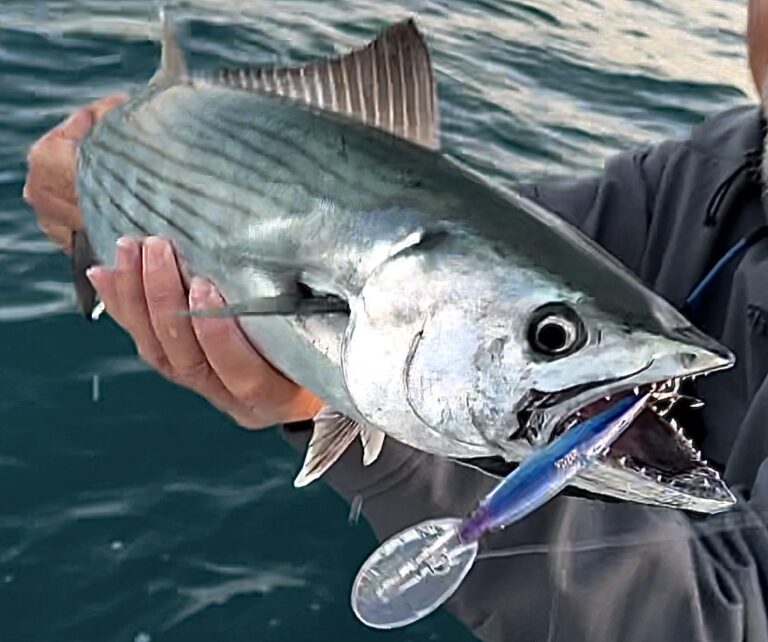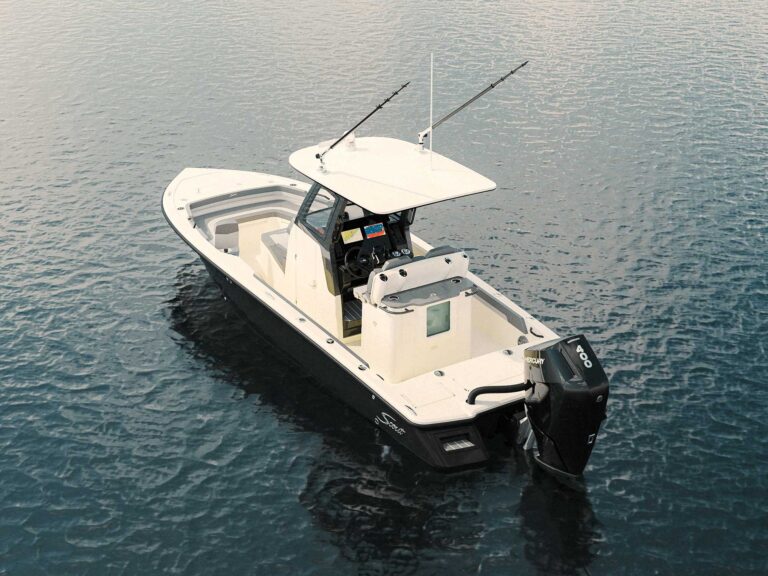World records come and world records go. That may sound a bit cavalier describing something as priceless and prestigious as an all-tackle world record, particularly for major game fish. But the fact is that such records are often surprisingly fleeting, broken by a larger fish caught years, months or even weeks later. In fact, there are many instances of world records being broken the same day they were set — even more than once! With that in mind, here are the 19 most impressive records to have stood the test of time — and are, like boxers who refused to go down, still standing.
There’s a reason these records have remained for decades. Actually there may be a couple of reasons, but the main one is that these fish are just too big to beat. It’s hard to say that any are unequivocally the largest of their species that ever lived. But to remain as records for 40 or 50 years — or nearly a century — well, they’ve got to be pretty damned close.
Some records are not only monsters for their species, but have gotten protection from laws that mean they can’t be challenged according to IGFA rules. Species which by law can’t be removed from the water can’t be weighed on a certified scale on land (or an object grounded in the earth). So in some cases, bigger fish have been caught but released without any possibility of weight record consideration. Fortunately, the IGFA also keeps records for records by length, so any species can qualify for length records. The records listed here are strictly weight records.
All-Tackle Atlantic Salmon World Record
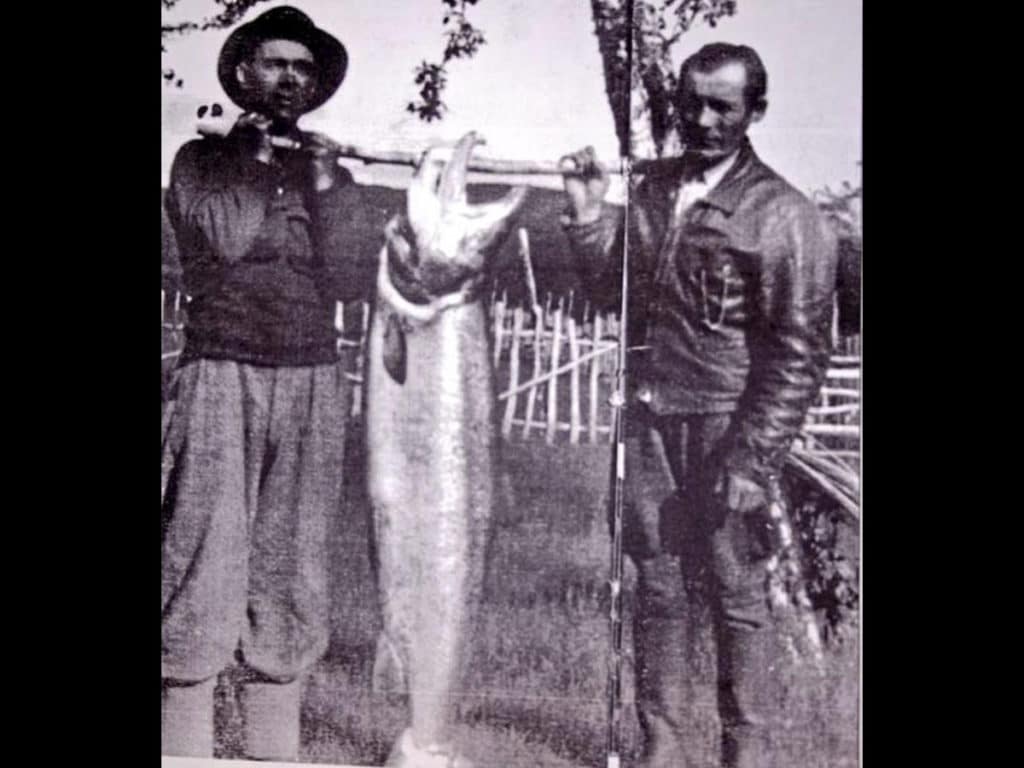
- Scientific name: Salmon salar
- Year: 1928
- Weight: 79 pounds, 2 ounces
The only IGFA record catch within spitting distance of celebrating its 100th anniversary, this enormous Atlantic salmon came from the Tana River in Norway in January, 1928, for angler Henrik Hennriksen (reportedly a fishing guide, and undoubtedly a hardy sort to be fishing a Norwegian river in the dead of winter — which is when Atlantic salmon often continue to spawn in these large rivers). No other details of the catch are known. The Tana River flows into the Barents Sea, but fishing isn’t what it used to be. Hoping to halt a decline in salmon populations, the river has been closed by Norway and Finland to salmon fishing in 2021 and 2022.
Large adults that return to Atlantic rivers typically have spent four years at sea, but can remain in the ocean longer, feeding and growing. (And they can return in later years; unlike Pacific salmon, they live to return to sea after spawning.) It is likely this record had spent at least five years at sea.
Could this record be defeated? Apparently the species can get even larger, to wit one weighing 109 pounds reportedly caught in a net in the estuary of the Hope River, Scotland in 1960. NOAA Fisheries reports a specimen 105 pounds, 60 inches long, but offers no details.
All-Tackle Pacific Sailfish World Record
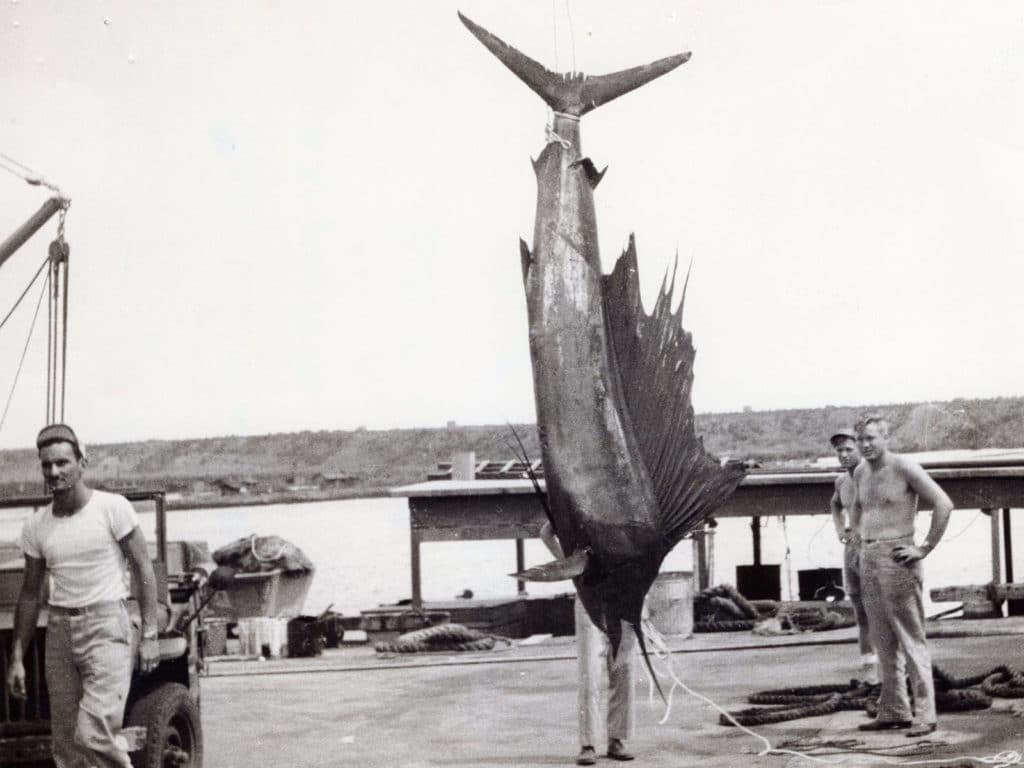
- Scientific name: Istiophorus platypterus
- Year: 1947
- Weight: 221 pounds
Just before mid-century last, angler Carl Stewart was fishing a mullet off Ecuador’s Isla Santa Cruz, when he landed what has remained for 75 years the all-tackle world-record Pacific sailfish.
In case you’re wondering, Pacific and Atlantic sailfishes are the very same species, though for many years they were listed as separate species. The IGFA separates them, perhaps in fairness because I. platypterus grows so much larger in the Pacific. (The all-tackle world record for the species in the Atlantic is a mere 142 pounds, 6 ounces.)
All-Tackle World Record Swordfish
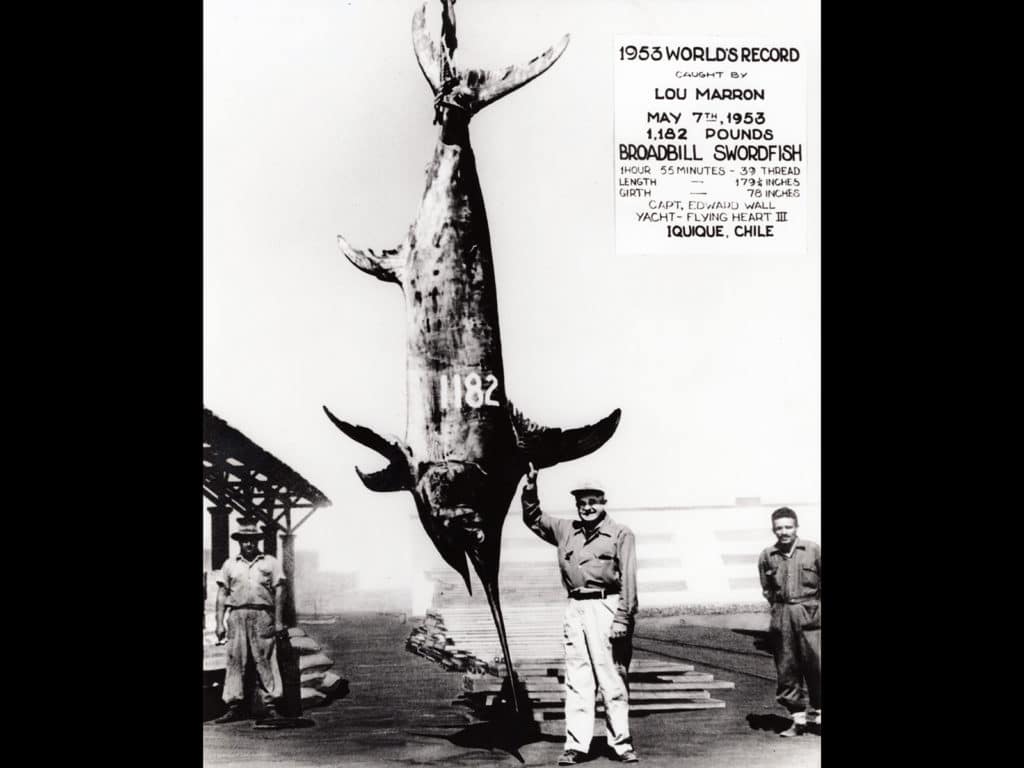
- Scientific Name: Xiphias gladius
- Year: 1953
- Weight: 1,182 pounds
When Lou Marron learned in 1953 that commercial fishermen had been harpooning huge swordfish off the coast of Chile, he made plans to travel there to catch giant swords. Along with his wife, Genie — also an angling enthusiast, holder of world records and oh, by the way, a concert pianist who had played at Carnegie Hall — the business tycoon commissioned the boat Flying Heart III, out of Iquique and skippered by Eddie Wall. On May 7, the bonito that Wall was trolling behind the boat was inhaled by the swordfish that Marron had come for. Fishing a Black Palm rod and 12/0 Fin-Nor reel spooled with 39-thread Cortland Super Cutty linen line, Marron brought the fish boatside in just under two hours. The enormity of the fish was manifest and, once wired, it caused moderate damage to the boat’s hull before it could be subdued.
The 1,182-pound sword became then and remains today easily the largest sword ever landed on rod and reel, occupying both all-tackle and men’s 130-pound-line-class categories. The next-largest swordfish in the IGFA record system weighed 891.5 pounds (from New Zealand). But no swordfish taken by any angler anywhere has even come close to Marron’s record.
All-Tackle Black Marlin World Record
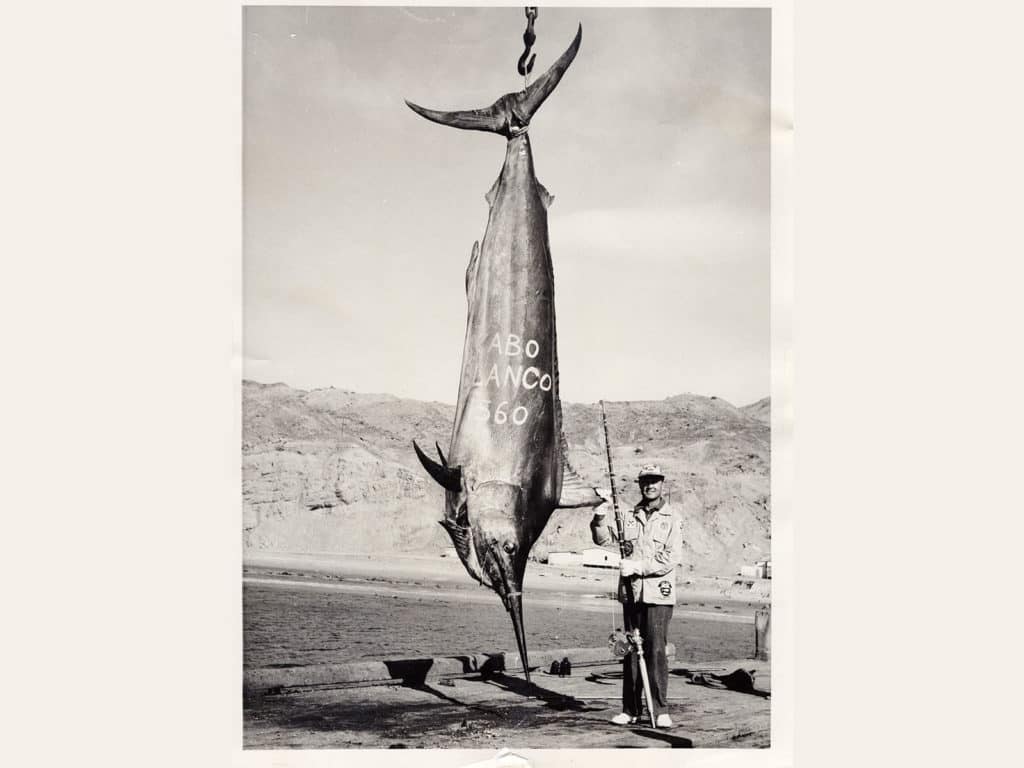
- Scientific name: Istiompax indica
- Year: 1953
- Weight: 1,560 pounds
In the early 1950s, the fishery in Cabo Blanco, Peru, began shaking up the fishing world, producing billfish of amazing size and granders in numbers. The newly formed Cabo Blanco Fishing Club brought some of the biggest names in the sport (yes, including Hemingway) to Talara, Peru, in DC4s, then over rugged roads to Cabo Blanco to try for huge marlin and swordfish, as well as XXL tunas and even man-sized Humboldt squid. By mid 1953, several grander marlin had been caught and Tom Bates’ 1,352 black in July of that year seemed insurmountable. Yet the next month, as Texas oilman Alfred Glassell trolled a 5-pound mackerel from the boat Petrel, skippered by Stirling Stuart, his bait was inhaled by what would prove to be the largest black marlin (or marlin of any species) ever caught on rod and reel. Like Lou Marron, Glassell favored the Fin-Nor 12/0 with 39-thread (130-pound) Ashaway line, tackle on which he fought the behemoth for an hour and 45 minutes.
Amazingly, a Warner Brothers film crew was out on the water that day looking for footage of a marlin that could look credible as Santiago’s monster for the movie version of The Old Man and the Sea. Clearly, they had come to the right place at the right time, as Glassell’s huge marlin performed for them, clearing the water fully 49 times during the fight.
At that time (in the 1950s, before the vast anchovy fishery was fished to death) and place (where huge predators gathered like nowhere else —and nowhere since) other catches actually came close to Glassell’s record, including a 1,540 and the 1,525 caught by New York public relations expert Kimberley Wiss — which remains the women’s 130-pound record to this day.
(For more on the amazing Cabo Blanco fishery, the likes of which has never been seen before or since, read the in-depth article, “The Greatest Big-Game Fishing the World Has Ever Known,” on sportfishingmag.com.)
All-Tackle Pacific Bigeye Tuna World Record
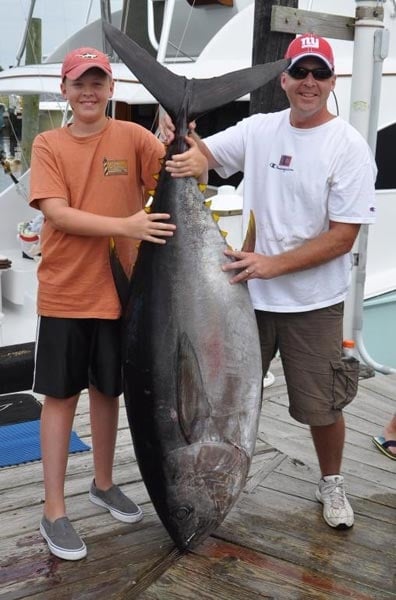
- Scientific name: Thunnus obesus
- Year: 1957
- Weight: 435 pounds
Yet another ostensibly unbeatable record from the phenomenal heyday of Peru’s Cabo Blanco fishery in the mid-1950s (see black marlin, above). At some point in the 65 years since this record was set, the original application form has been lost, leaving the IGFA with only the basic information. This is what we know: Dr. Russel Lee was fishing a bonito as bait off Cabo Blanco on April 17, 1957, when he hooked this immense bigeye on 39-thread linen line (equivalent, per the IGFA, with 130-pound mono) spooled onto an Ocean City 14/0 reel. The fish measured 7 feet, 9 inches in length. It’s unclear how much larger bigeye tuna may grow, but probably not much, which explains why this record has been on the books for so long.
All-Tackle White Shark World Record
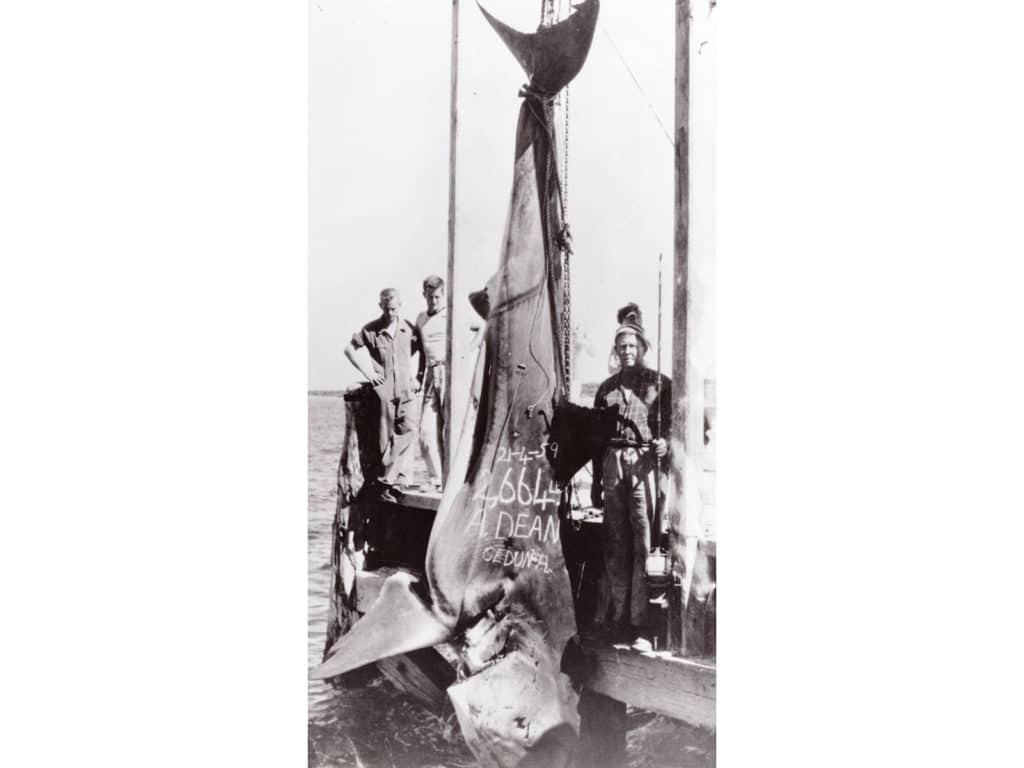
- Scientific name: Carcharodon carcharias
- Year: 1959
- Weight: 2,664 pounds
After the Second World War, fishing for white sharks the size of boats became an obsession with a fraternity of big-game anglers Down Under. By 1950, whites — known as white pointers in Australia — as large as 2,225 pounds had been weighed in. Port Lincoln, in the center of the continent’s southern coast, near Adelaide, was already known as a big-game-fishing destination, and it became ground zero for big-shark hunters.
One of the men determined to catch the world-record white pointer was Alf Dean, particularly upon hearing accounts of a massive white roaming Streaky Bay and nicknamed Barnacle Bill. Dean spent a night at anchor at the mouth of that bay, trailing a stream of whale oil to attract any whites around. In the middle of a dark 1951 night, banging against the hull meant the sharks had found them. In the lights, Dean could make out a white of typical size — and the other the biggest he’d ever seen. That was his new all-tackle record. In the morning, they put out the bait. The monster played its part and a mere hour and a half later, Dean and his team were towing it back to the dock where it weighed in at 2,333 pounds. He had his first record fish — and the first shark to exceed a ton.
Dean went on to catch more “tonner” whites over the next several years, with the angler at one point hunting an estimated 3,000-pounder. On April 4, 1959, off Ceduna (northwest of Port Lincoln), while drifting a chunk of porpoise (sorry, PETA, but this was a different era, different sensibilities) rigged onto two 18/0 Mustad hooks, Dean hooked what would be the all-tackle world record then and now, more than a half-century later. Fighting it with a Penn Senator 14/0 filled with Ashaway Dacron 130-pound line, Dean subdued the fish in just an hour. The shark measured nearly 17 feet, tip to tip, with an amazing 9 ½-foot girth.
Despite the frightening proportions of Dean’s record, white sharks get bigger. Much bigger. For example, Chris Fischer’s Ocearch shark-tagging operations have released several whites estimated at well over 4,000 pounds. A similarly large white was found off Japan in 2019 floating dead with a sea turtle stuck in its jaws. But though whites that dwarf even Dean’s monster are out there, the odds are good his record remains safe. Widespread laws make the retention of any white shark illegal, and of course estimated weights won’t cut it with IGFA rules.
All-Tackle Roosterfish World Record
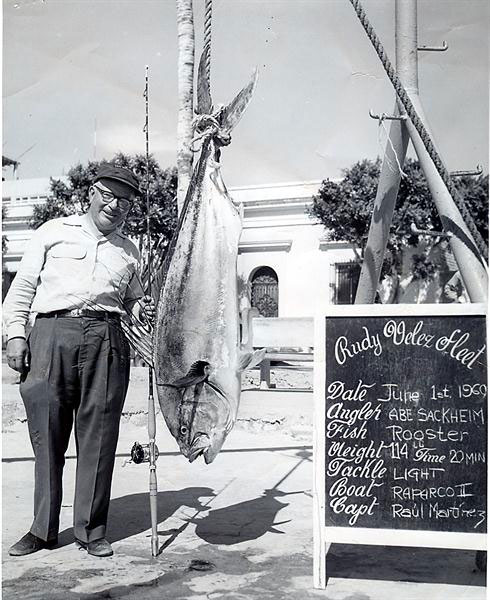
- Scientific name: Nematistius pectoralis
- Year: 1960
- Weight: 114 pounds
La Paz, Baja California Sur, has long prided itself on its world-class roosterfish fishing. One ironclad example of that remains angler Abe Sackheim’s 114-pound rooster, the IGFA all-tackle world record, caught off La Paz on June 1, 1960. Sackheim was trolling when the fish struck; however, this is another of the IGFA’s “lost records,” so we can’t know if Sackheim was pulling a bait or a lure. We do know that he was fishing Ashaway Dacron, 9 thread (27 pound), on a Penn 250 reel, and his record fish measured 64 inches.
Could this longstanding record be defeated? That seems quite possible, since we know roosters get even larger. A particularly vivid case in point is the estimated 135-pounder caught, yes, out of La Paz in 2013. Apparently several experienced sportfishing captains in pangas at the fishing grounds saw the fish and agreed that it had to weigh at least 134. But angler Ron Burgess released the rooster alive, almost certainly a new all-tackle record, rather than bring it to weigh it officially.
Given the rooster’s extensive range, from northern Peru to Mexico, it is almost certain roosterfish larger than 114 pounds are out there, but sufficiently few and far between that Sackheim’s record continues to stand after more than 60 years.
All-Tackle Goliath Grouper World Record
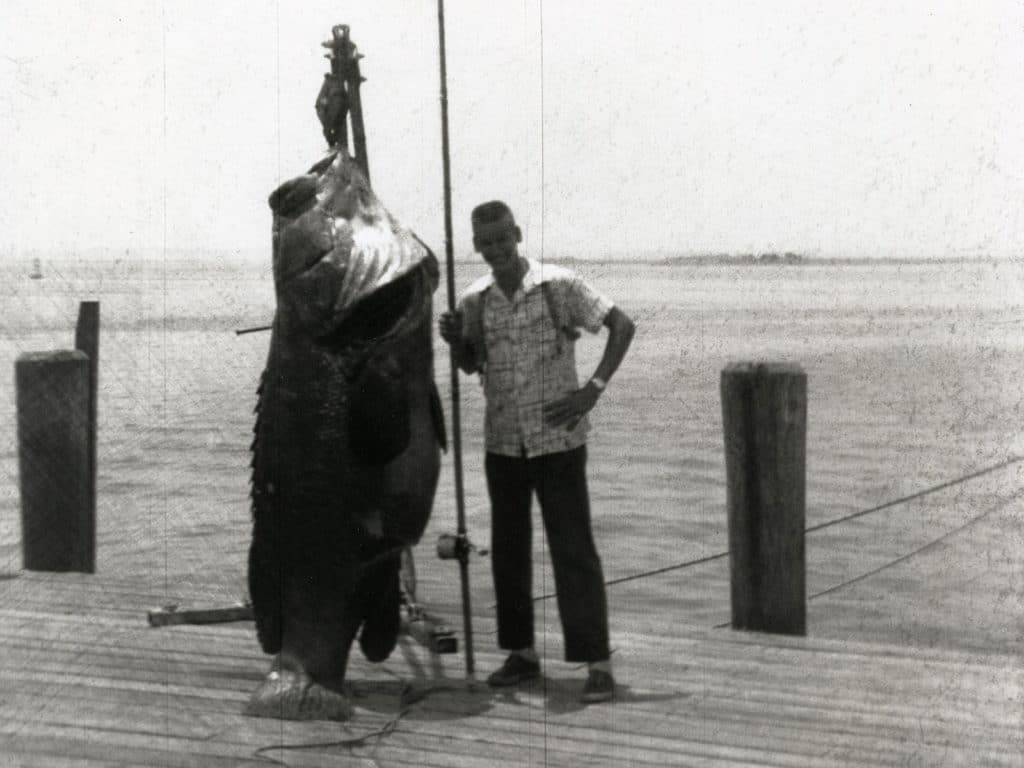
- Scientific name: Epinephelus itajara
- Year: 1961
- Weight: 680 pounds
Way back in May, 1961, when angler Lynn Joyner caught this world record, no one had ever heard of “goliath grouper.” They were known as jewfish, a name which has mostly fallen out of usage since the American Fisheries Society officially renamed E. itajara as goliath grouper in 2001. And, back in 1961 — when, in many fisheries, it was anything goes – regulations and limits didn’t prevent an angler like young Joyner from hauling a jewfish to the scales to be weighed and awed over.
And his catch merited some awe, dragging the scale down to 680 pounds. The colossal grouper swallowed a Spanish mackerel that the angler used as bait off a Fernandina Beach pier in northern Florida. Joyner fished the Ice Dock on the Amelia River (where the Ocean Port Authority now resides). Using a Penn 67 with 80-pound line, the 130-pound angler fought the fish for an hour and a quarter. Once the Joyner and two friends had secured the fish on a rope, it was hauled out by a wrecker, and weighed on a Container Corporation of America scale.
It’s impossible to say there aren’t goliaths larger than 680 pounds swimming around in warm Atlantic and Caribbean waters. But in the U.S. Southeast, where sport fishermen are most likely to hook them, no giants will be weighed in since the species has been protected for decades after fishing and, particularly, spearfishing reduced their numbers dramatically. Since then the species has rebounded, enough that despite considerable controversy, Florida will in the spring of 2023 allow a limited harvest of up to 200 goliaths per year, but with a slot limit of 24 to 36 inches. For reference, Joyner’s world record measured more than seven feet. So the widespread protection of goliath grouper offers the 1961 record pretty good protection.
All-Tackle Giant Sea Bass World Record
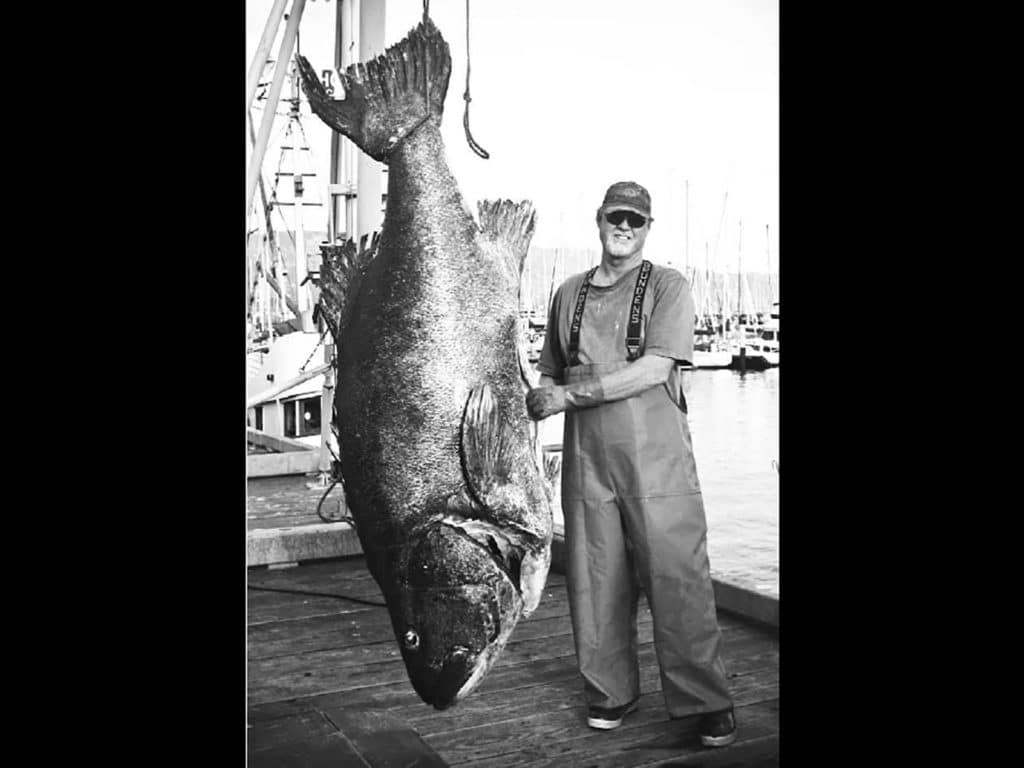
- Scientific name: Stereolepis gigas
- Year: 1968
- Weight: 563 pounds, 8 ounces
Few details of this record exist any longer with the IGFA. We know that the angler, James McAdam, Jr., made the catch on Aug. 20, 1968, fishing near Southern California’s Anacapa Island. We know he used a Penn 114H reel and 80-pound line (though not what sort of line), and that he was fishing a bonito.
Much like the mighty goliath grouper, the slow-growing California titan S. gigas has taken a major hit from both commercial and sport fishermen. They have been a protected species in California since 1982. The species is found only along the Southern California and Baja coasts.
Giant sea bass remain legal to keep in Mexican waters (where, studies suggest, the species is thriving) during the past four decades, but no fish larger than McAdam’s record have shot it down, and it may well continue to endure. Apparently the species does grow even larger; there’s no documentation for that, but anecdotal reports suggest that fish more than 700 pounds have been caught. In his signature work, The Channel Islands, Charles F. Holder in 1910 tells of an 800-pounder taken in the Sea of Cortez.
All-Tackle Bonefish World Record
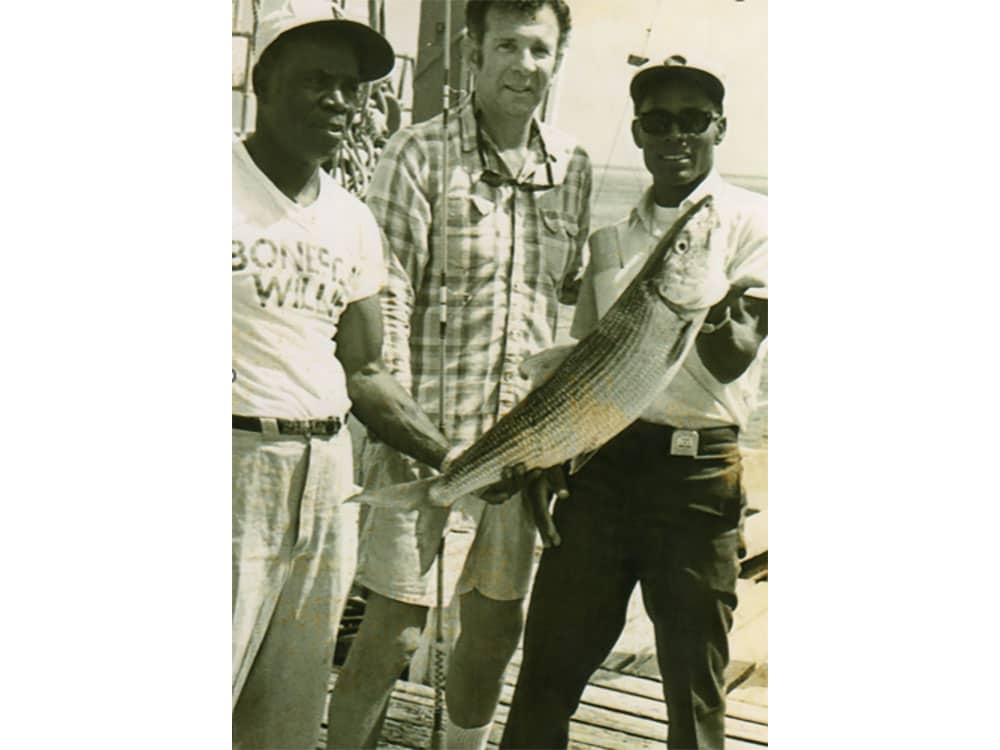
- Scientific name: Albula vulpes
- Year: 1971
- Weight: 16 pounds
Virginia Beach entrepreneur Jerry Lavenstein had been out with (now famous) Bimini guide Ansil Saunders enough to be a regular client. But this trip to Bimini in February, 1971, was a bit different since Lavenstein insisted he wanted to catch a world record bonefish. Saunders let him know that was a tall order, but off they went. He guided Lavenstein to three bonefish, the largest a five-pounder.
Next morning, the guide spotted something that caught his interest on a flat just 300 yards from the historic Bimini Big Game Club. Saunders poled cautiously toward a puff of mud until he spotted three big — very big — bonefish rooting in the mud as they searched for invertebrate morsels. He pointed them out to his angler, and Lavenstein managed to make a perfect cast, his live shrimp landing far enough beyond the bones to avoid spooking them. In short order, one had nailed the bait; the ensuing fight took 35 minutes, during which the bonefish twice stripped out more than 200 yards of eight-pound mono, nearly to the arbor knot.
Are there even bigger specimens of A. vulpes out there? Well, consider this. Saunders says the 16-pounder that Lavenstein caught that day was the smallest in that trio of fish.
Note that this 16-pounder is not the biggest bonefish of any kind ever landed. That distinction belongs to a Pacific species of Albula, an even longer-standing record. Caught surfcasting bait in deep water off a Zululand beach in South Africa in 1962, Brian Batchelor’s 19-pounder remains the biggest bonefish ever caught and registered with the IGFA.
All-Tackle Bluefish World Record
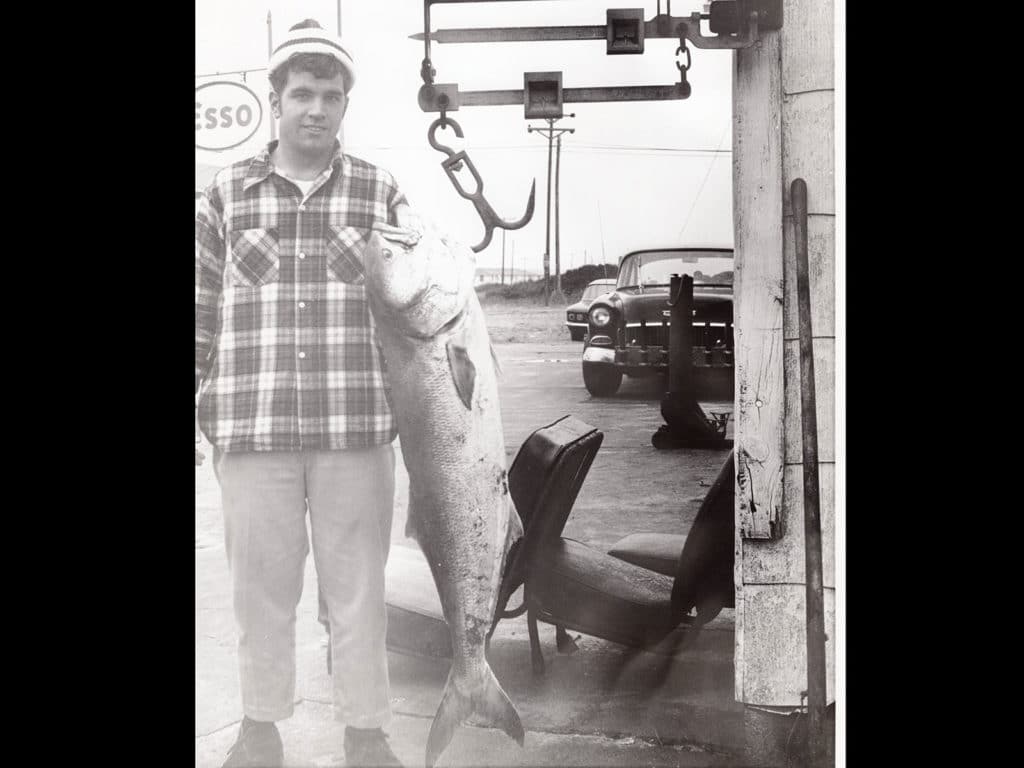
- Scientific name: Pomatomus saltatrix
- Year: 1972
- Weight: 31 pounds, 12 ounces
Jim Hussey, a Tarboro, North Carolina native, thought he had hooked a big striped bass. Hussey and a friend, James Simmons, were trolling Hatteras Inlet on Jan. 30, 1972. Hussey kept his Burke Jig-a-Doo Eel down in the strike zone amidst the powerful current using an eight-ounce sinker. After a 15-minute battle, with Hussey fighting the prize on a Penn 113H 4/0 filled with 30-pound Trilene mono, Simmons gaffed the huge blue. That turned out to be the only bluefish the angler caught that day, but what a bluefish. It proved to be the new world record, handily beating the 24 ½-pounder taken by Rita Mizelle, also in North Carolina waters — at Nags Head — the year before.
Thus far, there’s no evidence for larger bluefish, and the fact that this record has stood for 50 years suggests that blues don’t get much larger. But it’s a big world, and bluefish are relentless predators that swim temperate waters worldwide; they’re called tailor in Australia, and are rumored to grow to more than 40 pounds off western Africa. But if there’s a blue larger than 31 pounds, 12 ounces, it has yet to be caught and submitted for record status.
All-Tackle Black Drum World Record
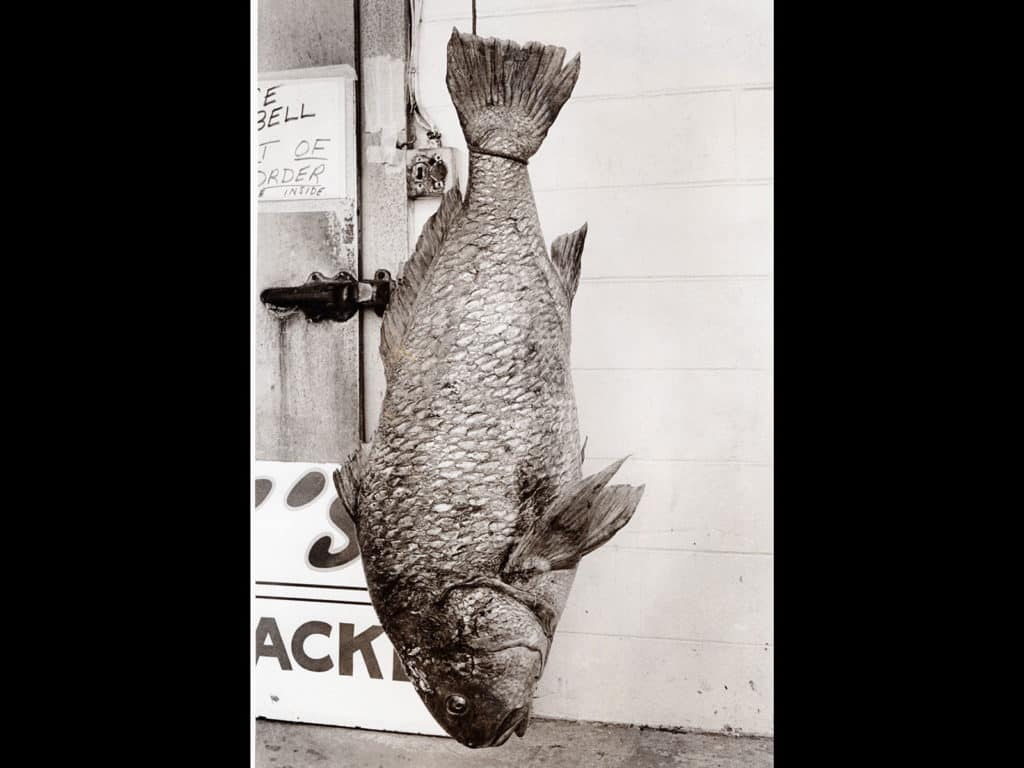
- Scientific name: Pogonias cromis
- Year: 1975
- Weight: 113 pounds, 1 ounce
The time was wrong and the bait was wrong for this unlikeliest of record catches. While we can only guess what angler Gerald M. Townsend, of Ocean View, Delaware, had on his mind when he cast out a chunk of cut mullet off the beach at Cape Henlopen on Sept. 15, 1975, one might suppose it wasn’t black drum. After all, while Delaware Bay is indeed a well-known hot spot for monster blacks, that’s a May-June fishery. No one targets these fish in these waters in September. And while mullet is known to be a good bait, not so much for black drum. Anglers after blacks generally favor crabs or a gob of surf clams.
Yet, Townsend hooked the catch of his life and struggled to bring it to the beach for a half hour. He was fishing a Penn Squidder 140 with 25-pound Berkley Trilene mono.
Published references typically say black drum reach 120 pounds. Perhaps they do; but while there seems to be no evidence of any that size landed, a 1987 Virginia Institute of Marine Science report cites a 1928 reference listing a 66.3-kilogram (146.2-pound) black drum, so yeah, chances are a 120-pounder and then some is out there somewhere between the New England coast and Texas, the species’ range.
All-Tackle Dolphin World Record (dolphinfish, mahi, dorado)
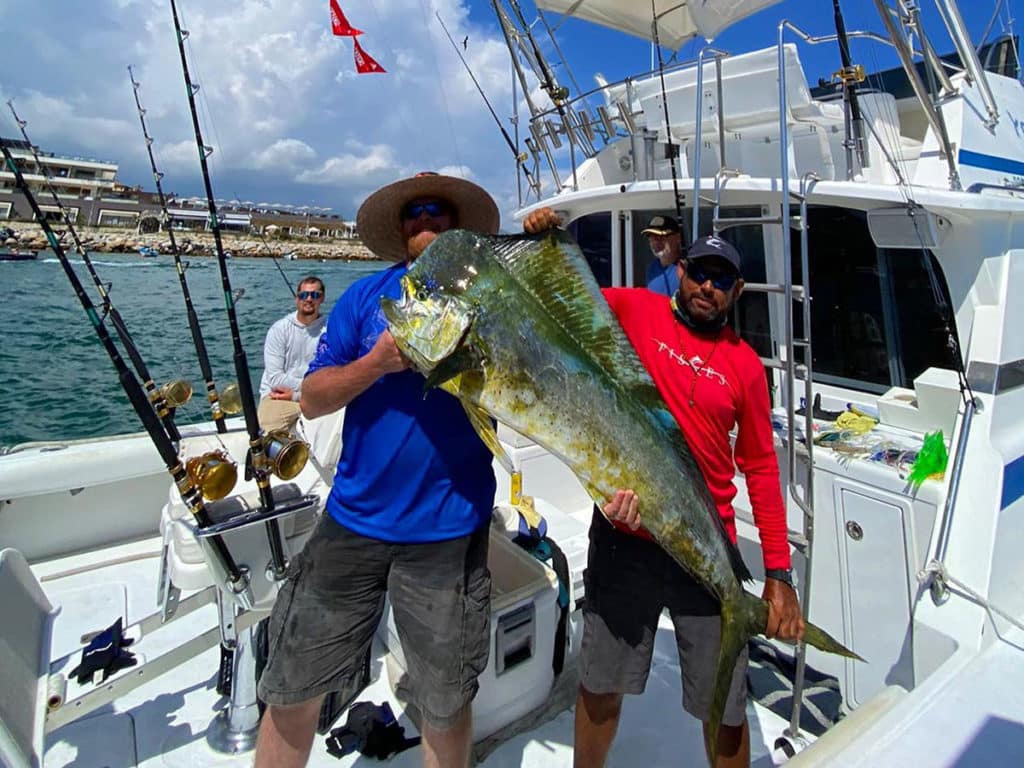
- Scientific name: Coryphaena hippurus
- Year: 1976
- Weight: 87 pounds
Trolling a soft-plastic squid in the Papagayo Gulf, off the northern Costa Rica coast, on Sept. 25, 1976, Manuel Salazar hooked his huge dorado. He fought it to the boat with a Penn Senator 6/0 spooled with 50-pound mono. The mahi measured 69.5 inches in length. This is another lost record, so we have no details beyond this.
Thousands and thousands of mahi are caught annually around the world in tropical blue waters, yet none has threatened this record in nearly 50 years. But larger mahi have been caught. One notable: the somewhere-around-a-hundred-pounds dorado pulled aboard a Pisces Sportfishing charter out of Cabo San Lucas in 2015. Since it was fileted before it could be weighed on a certified scale, it could never be the world record. But a hanging spring scale the anglers used showed it to weigh 102 pounds. Scientists suggested a 94-pound weight based on the fish’s 66-inch length. Either way, it suggests that even after half a decade, Salazar’s 87-pound record might not be safe.
All-Tackle Albacore World Record
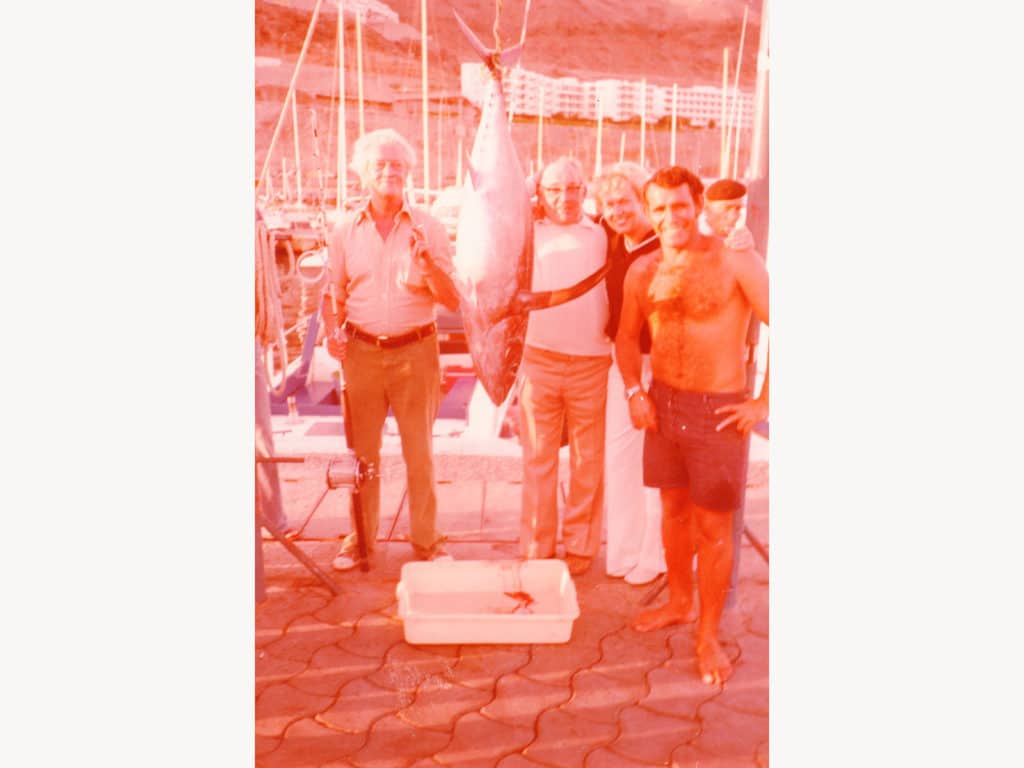
- Scientific name: Thunnus alalunga
- Year: 1977
- Weight: 88 pounds, 2 ounces
Not to be confused with “false albacore,” as little tunny (Euthynnus alletteratus) are generally labeled by anglers off the U.S. Northeast and Mid-Atlantic coasts, the true albacore tuna is a global nomad, found in all warm temperate seas. One area that has produced exceptionally large albacore (large for the species: albacore are one of the smaller tunas) is the Canary Islands, off Spain. These waters produced four all-tackle records for T. alalunga between 1973 and 1977, the last of these remaining the record to this day. That was taken by German angler Siegfried Dickemann while drifting a live mackerel on Nov. 19, 1977. The angler was likely after bigger game since he was using a 9/0 reel with 80-pound line.
It’s safe to say albacore do grow larger, at least a bit. In 1997, Don Giberson caught a 90-pound, 4-ounce albacore off Santa Cruz, California. That might have defeated Dickemann’s record but the fish was caught on a Zuker trolling lure with a standard double-hook rig that happened to be just out of compliance with IGFA rules for such two-hook rigs, and on that basis was disallowed as a record. The fish remains the California state record. There are reports of even large albacore taken in the Japanese tuna fishery, but those remain just that — reports.
All-Tackle Snook World Record
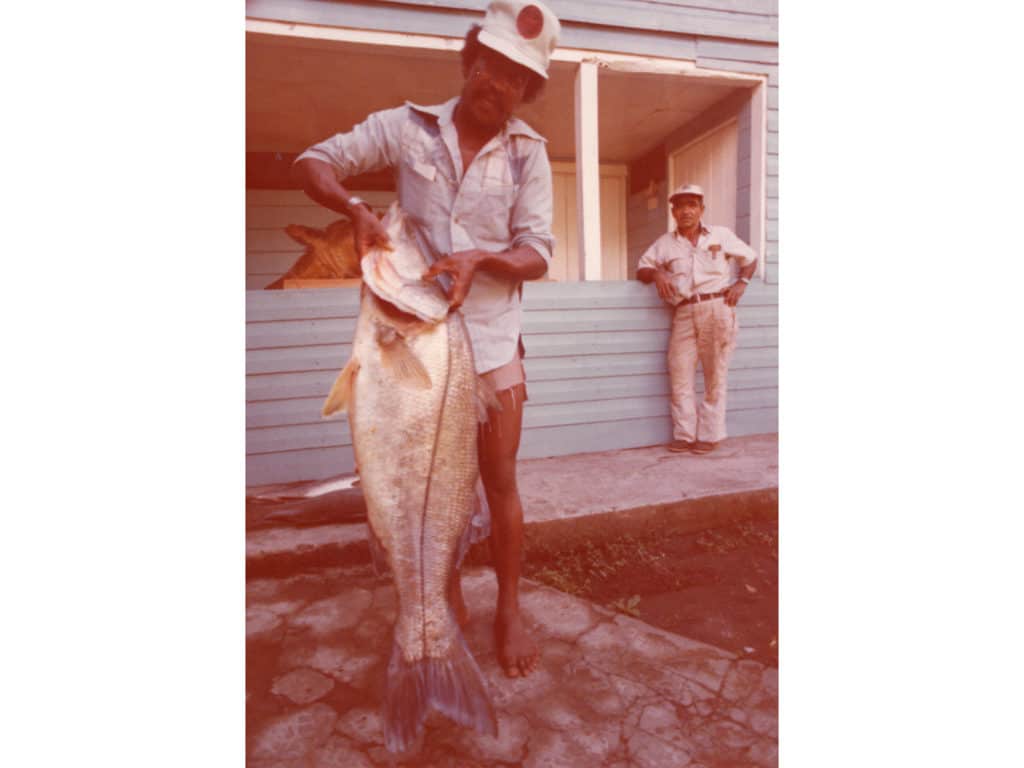
- Scientific name: Centropomus undecimalis
- Year: 1978
- Weight: 53 pounds, 10 ounces
Perhaps Gilbert Ponzi would have armed himself with a somewhat heavier outfit and line stronger than 15-pound test on that October day in 1978 had he any inkling that he would hook the largest snook ever recorded by the IGFA from the Atlantic. Ponzi cast a bucktail jig with his Ambassadeur baitcaster in Costa Rica’s Parismina River when the enormous snook struck. A challenging 45-minute battle ensued.
There may be snook larger than Ponzi’s record swimming around in Atlantic estuaries, but it seems debatable without much evidence of that. Are there larger snook elsewhere? Absolutely: the world-record Pacific black snook (Centropomus nigrescens), caught off Quepos, Costa Rica, in 2014, weighed in at a whopping 59 pounds, 8 ounces. The angler, Capt. Ward Michaels, fishing a live sardine, was well prepared with 65-pound Sufix line.
All-Tackle Bluefin Tuna World Record
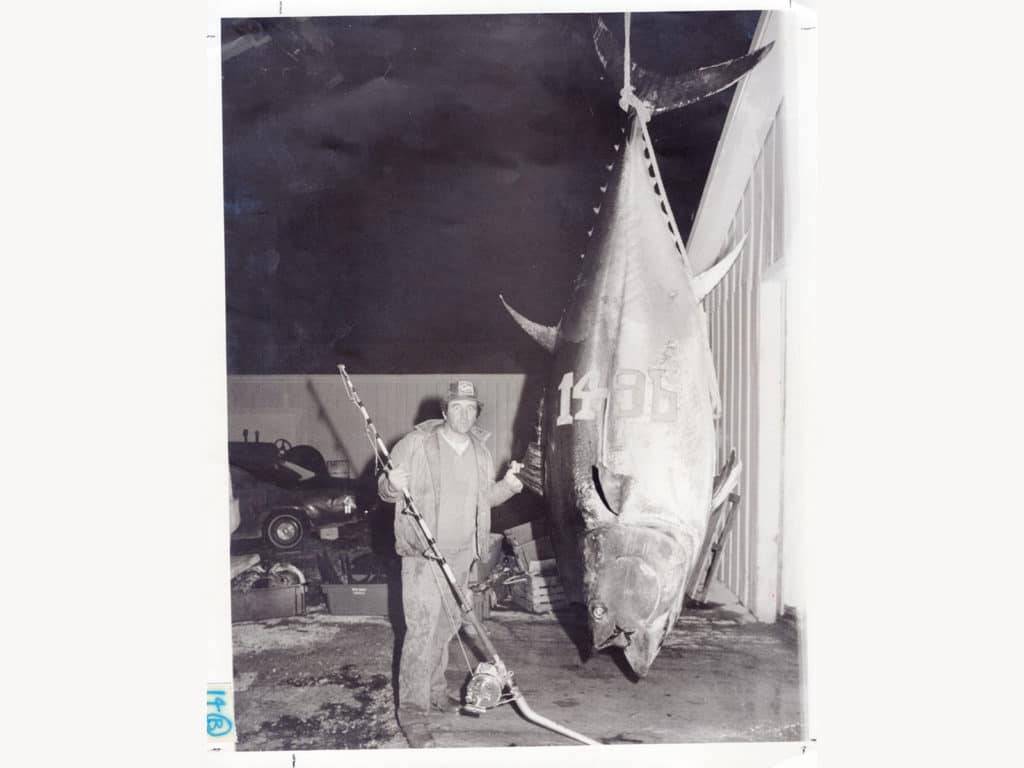
- Scientific name: Thunnus thynnus
- Year: 1979
- Weight: 1,496 pounds
While grander bluefin aren’t exactly a dime a dozen, they’re not unheard of, and bluefin have been caught as large as 1,200 pounds. But only one tuna, ever, has weighed in at nearly 1,500 pounds. Ken Fraser’s gargantuan bluefin record has held from 1979 and is one record likely to endure.
Fraser, an IGFA representative, has devoted his life to the quest of giant bluefin (and caught several over 1,000 pounds). He was trolling a mackerel in Nova Scotia’s Aulds Cove, on the southwest end of Cape Breton Island, on Oct. 26, 1979, with Capt. Eric Samson aboard the 38-foot Lady and Misty, out of Port Hood, when he connected with the tuna of a lifetime. Fraser fished a Fenwick bent-butt rod and Penn International 14/0 with 130-pound line. Remarkably, he brought the fish to gaff in just 45 minutes.
As heavy as it was at weigh in, that tantalizing 1,500-pound mark might have been realized had the fish been weighed in right away, but it remained on deck nearly 10 hours before it hit the docks. At nearly 11 feet in length, the fish dwarfed its captor. The tuna’s girth was better than eight feet.
All-Tackle White Marlin World Record
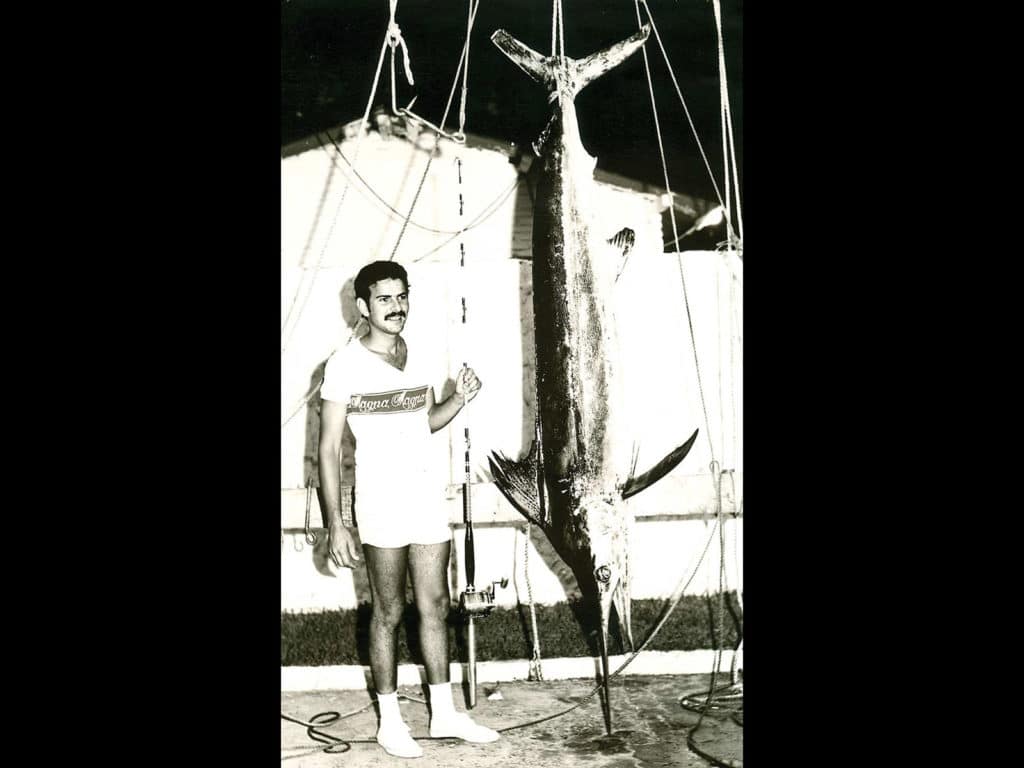
- Scientific name: Kajikia albida
- Year: 1979
- Weight: 181 pounds, 14 ounces
To get an idea just how enormous a white marlin weighing nearly 182 pounds is for that species, consider that in the storied history of the White Marlin Open, a 99-pounder is the largest white taken to date. Whites, which occur from New England to Brazil and along most of western Africa are typically under a hundred pounds.
It became quickly obvious to angler Evandro Coser that the marlin he hooked off Vitoria, Brazil, on Dec. 8, 1979, wasn’t your average white. Coser was trolling a bait when the white hit. (Many details of this catch, including the actual bait and fighting time, are no longer available.) Fishing a Penn International 30 with 30-pound Ande mono, Coser brought to the boat a white marlin larger than anyone had ever seen. It measured nearly 10 feet in total length. Coser, by the way, continues to fish Brazil for marlin, recently with Capt. Shawn Wallace on the Majestic Marlin out of Canavieiras.
All-Tackle Chinese Seerfish World Record

- Scientific name: Scomberomorus sinensis
- Year: 1982
- Weight: 288 pounds, 12 ounces
Also known as Chinese mackerel, the seerfish is a close relative of the kingfish and Spanish mackerel so popular among U.S. anglers. Indeed, it’s the same genus, Scomberomorus, though found only in the Western Pacific — particularly the China Sea. But unlike puny kingfish, it grows to frightening proportions, by far the largest of all the mackerels. And it’s a really cool fish — swimming far up rivers into fresh water, reportedly as far as 185 miles up the Mekong River.
In profile, the seerfish resembles the dogfish tuna — enough that the angler who caught the longstanding all-tackle record on Oct. 6 , 1982, submitted it as a dogtooth tuna! But plenty of characteristics distinguish the seerfish, with its far smaller eye, curved tail, smaller teeth and the like, which the IGFA saw at a glance, correcting the species I.D.
These oversized mackerel are caught by anglers jigging or, like Boo-Il Oh, of Seoul, South Korea, trolling. Oh was using a live yellowtail as bait when the massive mackerel struck near South Korea’s Kwan-Tall Island. Fortunately, he was rigged for heavy running with 80-pound Gudebrod line on his Penn International 80 on a Fenwick bent-butt rod. Even so, a 52-minute fight ensued before Oh could get the eight-foot-long mackerel to the boat.
All-Tackle White Sturgeon World Record
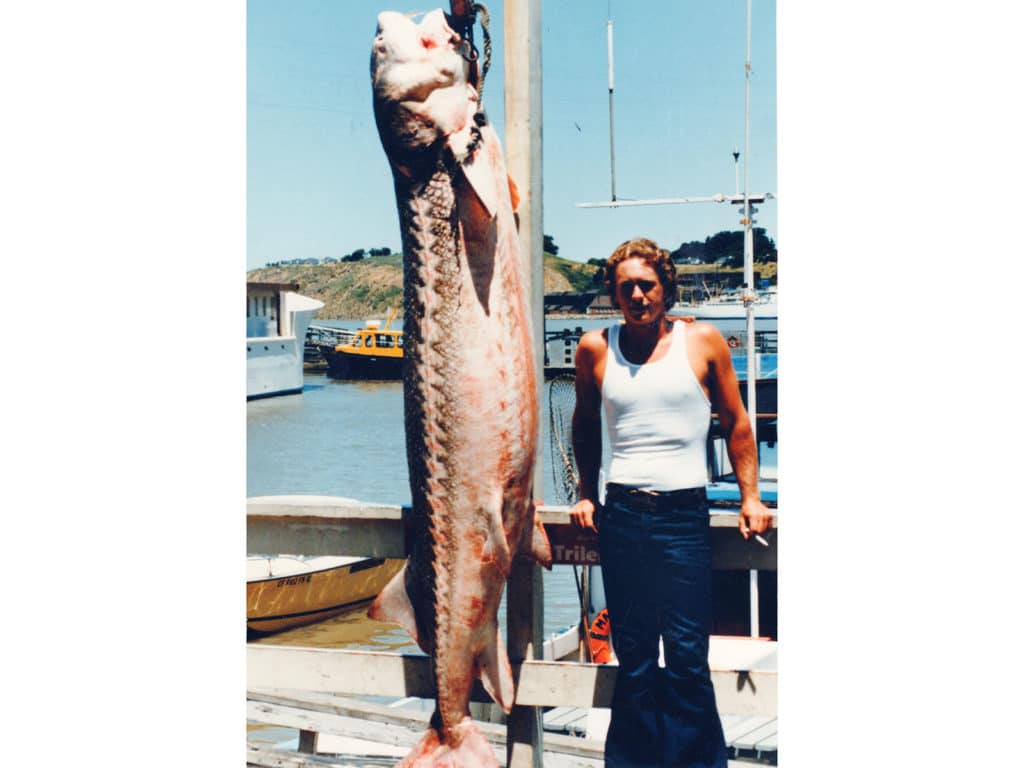
- Scientific name: Acipenser transmontanus
- Year: 1983
- Weight: 468 pounds
Sometimes-deckhand and sturgeon enthusiast Joey Pallotta was after a big fish on the July day in 1983 when he headed out on his 18-foot boat with girlfriend Lisa Gifford. When something tapped the shrimp he was soaking in Northern California’s San Pablo Bay just south of the Benicia Bridge, Pallotta got his wish. That moment began a battle that lasted five hours, during which time the sturgeon jumped, even tailwalking like a marlin, and the angler — holding the rod at all times — hopped into a friend’s 26-foot boat. Pallotta had called his friend for help when he saw the size of the sturgeon.
“The fish surfaced immediately,” he said at the time, “and when I first saw it, I went into shock. Even if I could fight it, I didn’t think there was any way we could get it into [my] boat.” The angler used a Fenwick rod and Daiwa reel with 60-pound Stren.
Along with the Columbia River that divides Oregon and Washington, southern British Columbia’s Fraser River has become ground zero for monster white sturgeon. In 2021, anglers fishing with Sturgeon Slayers tagged and released a Fraser River fish taped out at 11 feet, 6 inches (fork length). Though no weight could be taken, for reference consider Pallotta’s 468-pounder that measured 8 feet, 6 inches; a sturgeon 11 ½ feet in length would likely weigh 800 to 900 pounds.
However, none of these behemoths will ever be weighed on a certified scale and submitted for a record, because laws throughout their range in North America forbid removing such giants from the water. (Far smaller fish are legal to harvest in some waters.) So, Joey Pallotta’s all-tackle record from 1983, thus far the largest freshwater fish taken on rod and reel, will continue to stand.
All-Tackle Red Drum World Record (redfish)
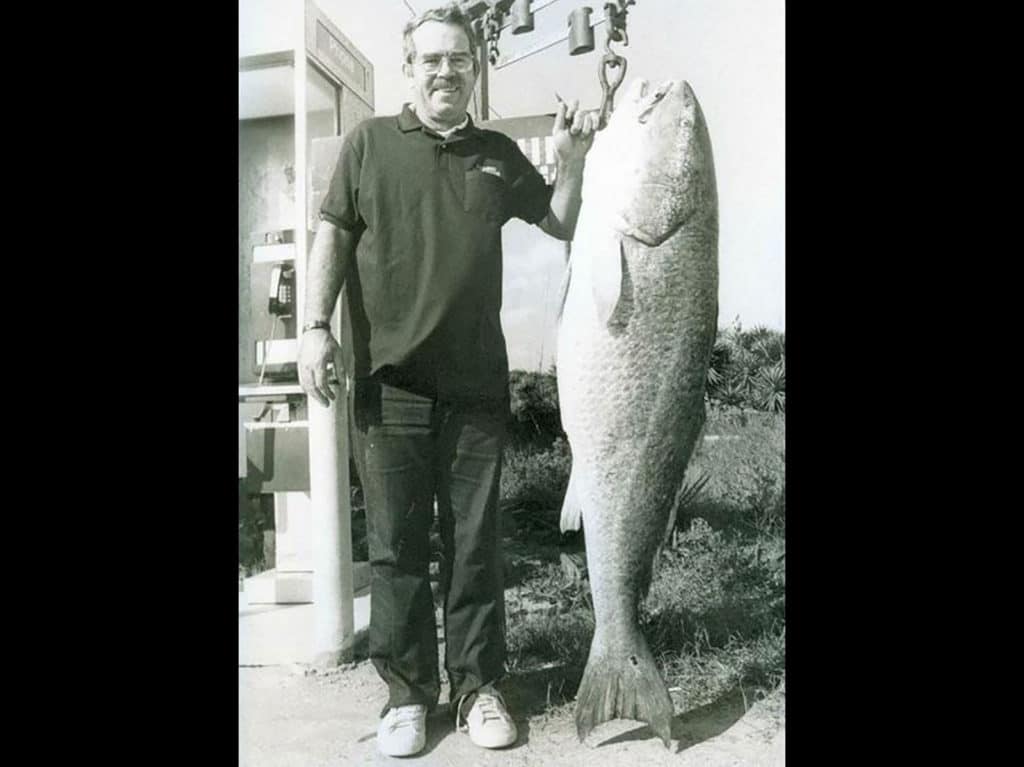
- Scientific name: Sciaenops ocellatus
- Year: 1984
- Weight: 94 pounds, 2 ounces
Although it’s the most recent record on this list, David Deuel’s 94-pound, 2-ounce red drum has remained entrenched as the biggest red drum ever caught on rod and reel for 38 years, suggesting there aren’t many bigger ones swimming around the Atlantic. The angler, then a scientist with the National Marine Fisheries Service and avid drum enthusiast, was fishing the fall run in the same area where anglers before him had also caught world-record redfish (to about 90 pounds, the all-tackle record Deuel’s catch defeated): the surf near Hatteras, North Carolina.
Specifically, the angler soaked his chunk of mullet at Avon on Nov. 7, 1984, to catch the beast, which he did after a 45-minute fight on a Daiwa SurfSpin rod and a Daiwa 7000C reel spooled with 17-pound Stren. At weigh-in, the fish measured three inches short of five feet, with a hefty 38-inch girth.
Editor’s Note: Anglers interested in supporting sport fishing worldwide should consider buying a membership to the International Game Fish Association (IGFA). Salt Water Sportsman is a strong supporter of the IGFA and their mission. IGFA members receive access to the IGFA World Record database, historical videos, a monthly International Angler digital publication, and discounts on tackle and charters from IGFA partners.






